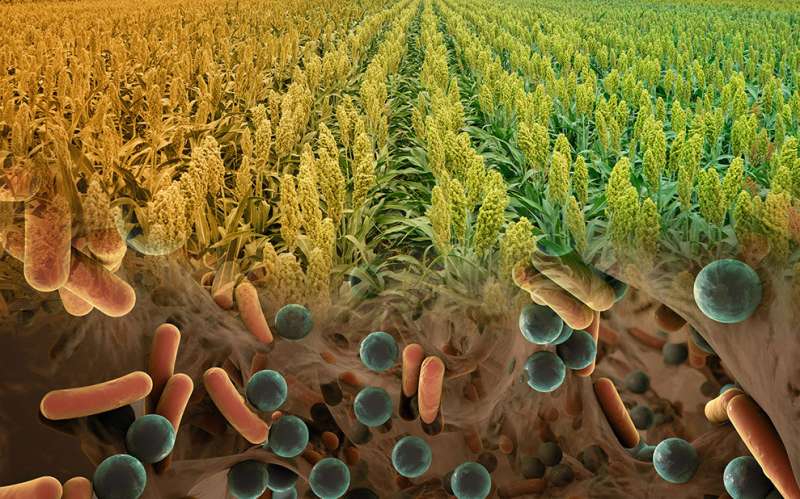During droughts, bacteria help sorghum continue growing

The devastating effects of drought are expected to increase in severity and frequency in the coming years. To protect the world's food supply, scientists turn to genetic engineering. Now, a team of researchers has discovered how changes in the microbiome—the ecosystem of bacteria and other microorganisms attached to the roots of plants and in the soil surrounding it—may improve drought tolerance in plants.
Drought stress is a major obstacle in agriculture. Bacteria associated with the roots of some plants can mitigate the effects of drought on plant growth. Understanding the causes and timing of changes in the microbiome could lead to strategies that make the most of this natural drought-protection and improve plant productivity worldwide.
Researchers from the University of California at Berkeley, University of California at Davis, Agricultural Research Service of the U.S. Department of Agriculture, Pacific Northwest National Laboratory, Lawrence Berkeley National Laboratory, and Kearney Agricultural Research and Extension Center studied the microbial community associated with sorghum. This important bioenergy and feed crop in the United States is also a food staple in the developing world. The team took weekly samples of sorghum plants over a four-month period when the fields were experiencing drought conditions. They compared how the sorghum microbiome and plant root metabolome changed over that time. The team discovered that drought primarily increases the abundance and activity of monoderm Actinobacteria in both the soil surrounding the roots and plant tissue. Metatranscriptomics studies of gene activities (a profile of community-wide gene expression) revealed, during drought conditions, these monoderm bacteria increased transcription of genes related to metabolite transport. Using a gas chromatography mass spectrometer at EMSL, the Environmental Molecular Sciences Laboratory, a Department of Energy Office of Science user facility, the team further characterized the sorghum root metabolites and correlated them with significant changes in the soil bacteria. The results led scientists to believe sorghum under drought stress exudes metabolites that select for monoderm Actinobacteria in the surrounding root area and these bacteria may enable sorghum to cope better with drought stress. This discovery may hold insights into how plants such as sorghum manage or influence soil microbiomes, which in turn may promote drought hardiness in plants.
The work is part of the Epigenetic Control of Drought Response in Sorghum (EPICON) project, which seeks to develop an in-depth understanding of the drought tolerance of sorghum in the field and leads the way for enhancing bioenergy crop production on marginal land.
More information: Ling Xu et al. Drought delays development of the sorghum root microbiome and enriches for monoderm bacteria, Proceedings of the National Academy of Sciences (2018). DOI: 10.1073/pnas.1717308115
Journal information: Proceedings of the National Academy of Sciences
Provided by US Department of Energy




















